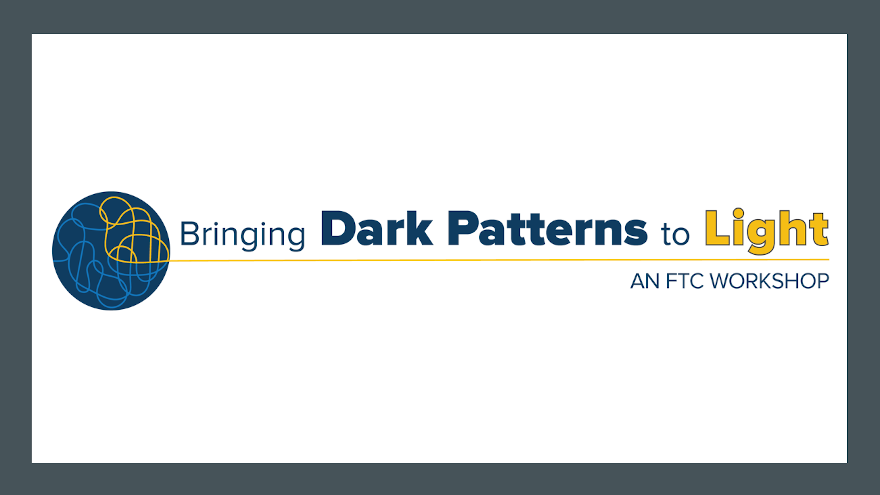FTC seeking array of info about ‘dark patterns’

Image courtesy of the FTC.
“Dark patterns” evidently are not just what might appear below your eyes after a long day followed by a restless night.
The Federal Trade Commission is seeking comment on topics related to the use of digital “dark patterns,” a range of potentially deceptive or unfair user interface designs used on websites and mobile apps. The regulator is looking for this material to enhance discussions during the agency’s workshop scheduled for April 29.
The FTC is seeking comment on several topics that will be in focus at the event titled, Bringing Dark Patterns to Light: An FTC Workshop, including:
• The definition of dark patterns
• The prevalence of dark patterns in the marketplace
• The use of artificial intelligence and machine learning to design and deliver dark patterns
• The effectiveness of dark patterns at influencing consumer choice, decision-making, or behavior
• The harms dark patterns pose to consumers or competition
• Ways to prevent, mitigate, and remediate the harmful effects of dark patterns.
While the workshop is on tap for the end of the month, firms and their experts have until May 29 to share information as FTC said is particularly interested in data, studies, research and other empirical evidence addressing these issues. Officials elaborated about what they’re seeking here, including:
1. Defining Dark Patterns
What is a dark pattern? Is there an accepted definition of the term? What features do dark patterns have in common, and how do they differ? How do dark patterns differ from other types of persuasive technology and techniques (e.g., design features known as “nudges”)? How do dark patterns differ from analogous sales and advertising tactics in the brick-and-mortar context? Are they different in scale, in kind, or both?
2. Prevalence of Dark Patterns
How prevalent are dark patterns in the marketplace? Are there particular industries, subsets of industries, or stages of companies (e.g., startups) where dark patterns in general or specific dark patterns are especially prevalent or, conversely, where participants are unlikely to use dark patterns? Are dark patterns more prevalent on certain platforms or mediums (e.g., mobile apps, video games, social media platforms)?
3. Factors Affecting Dark Pattern Adoption
What factors influence a company or organization’s decision to employ dark patterns? What role has A/B and other user experience testing played in the development and spread of dark patterns? How has “growth hacking” and related strategies contributed to dark patterns? Why do many companies employ the same or similar dark patterns?
4. Dark Patterns and Machine Learning
How are artificial intelligence and machine learning affecting dark patterns? Is there empirical evidence of companies using artificial intelligence or machine learning to personalize and serve dark patterns to individual consumers or specific groups of consumers?
5. Effectiveness of Dark Patterns
How effective are dark patterns at influencing consumer choice, decision-making, or behavior? Are some dark patterns more effective than others? Which ones are most effective? What makes them more effective?
6. Harms of Dark Patterns
What harms do dark patterns pose to consumers or competition? For example, do certain dark patterns lead consumers to purchase products or services that they might not otherwise have purchased, pay for products or services without knowing or intending to, provide personal information, waste time, spend more on a particular product or service, remain enrolled in a service they might otherwise cancel, or develop harmful usage habits? Are any groups of consumers more likely than others to be affected by dark patterns (e.g., young children, teens, older adults, persons with low income)? Do dark patterns have a disproportionate impact on consumers of color or other historically disadvantaged groups? Do dark patterns have any pro-consumer or pro-competition benefits? What are they?
7. Consumer Perception of Dark Patterns
How able are consumers to detect dark patterns? Are consumers able to detect some dark patterns better than others? Even when consumers detect a dark pattern, are they likely to understand how it is influencing their behavior? Do any disclosures made in connection with dark patterns help consumers detect and avoid them?
8. Market Constraints and Self-Regulation
Do market forces (e.g., competition and reputational concerns) sufficiently prevent companies from using harmful dark patterns? How responsive are companies to the potential reputational effect of being labeled as having used a dark pattern by organizations such as DarkPatterns.org? What self-regulatory measures are companies and other stakeholders taking to mitigate the harms of dark patterns? Are there any industry standards regarding the use of dark patterns? How is compliance with any such standards monitored and enforced?
9. Solutions
What would effective prevention, mitigation, and remediation of the harmful effects of dark patterns look like? What role can industry play in preventing, mitigating, and remediating the harmful effects of dark patterns? What types of dark patterns or use cases of dark patterns should the FTC and other government regulators focus on when bringing enforcement actions and engaging in other initiatives to combat dark patterns that are deceptive or unfair, or violate the law in other ways? Given that consumers may be unaware of dark patterns’ effects on their behavior and decisions and therefore less likely to complain, what can the FTC and other regulators do to identify and combat deceptive, unfair, or otherwise unlawful dark patterns?
All of the requested submissions can be submitted via this website.


